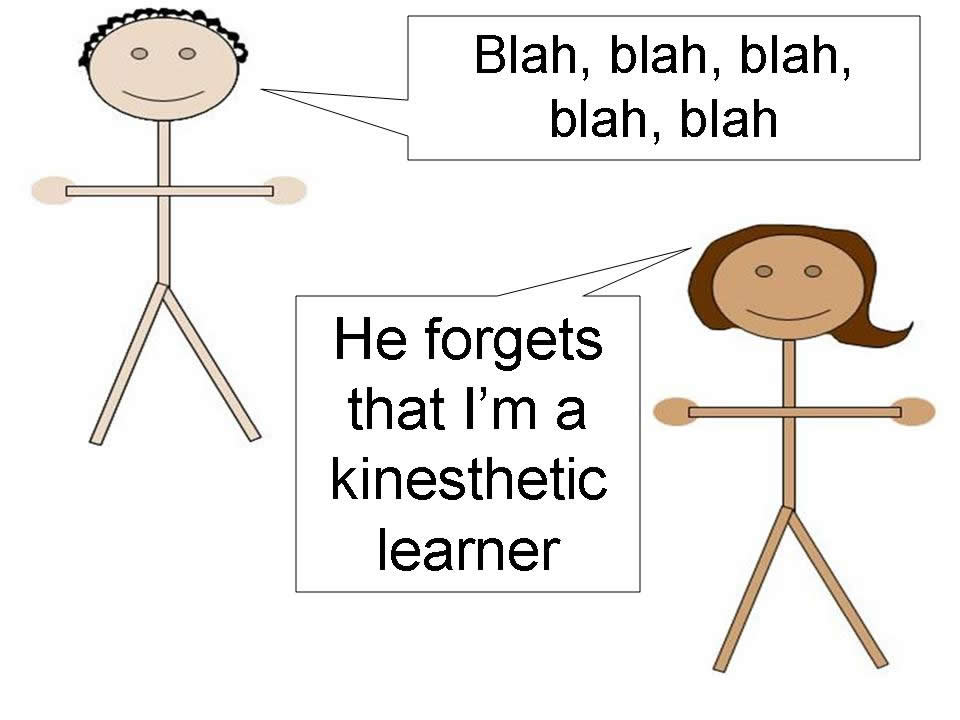Lesson 5: Learning Styles
Attention
.png)
You have probably heard the phrase "Learning Styles"
Learning Styles are our preferred ways of processing and learning information. We find information presented to us in this chosen manner to be easier to understand. However, even though some teachers will try to present information in different ways, it is useful to understand your PREFERRED styles and how to adapt to OTHER STYLES of information so you can be successful in all your courses!
Learning Outcomes
Upon completion of this lesson's material, students will be able to:
- Identify and describe their preferred learning styles
- Describe how they may adapt learning materials and incompatible teaching styles to personal learning styles
Teaching
Each of us is a unique learner; we all have our own study methods that we’ve come to use and rely on based on experience and practice, but are we using the best learning techniques for our innate learning style? Understanding which type of learner you are is crucial for figuring out what the best way for you to learn is. Don’t worry, it is not too hard. While we are all different learners and there are hundreds of different learning “tricks”, there are still a few broad categories for learning styles, and we tend to fit into one or the other best.
Types of Learning Styles: The Three Main Types
There are three main types of learning styles: auditory, visual, and kinesthetic. Most people learn best through a combination of the three types of learning styles, but everybody is different.
| Auditory Learners: Hear | Visual Learners: See | Kinesthetic Learners: Touch |
|---|---|---|
Auditory learners would rather listen to things being explained than read about them. Reciting information out loud and having music in the background may be a common study method. Other noises may become a distraction resulting in a need for a relatively quiet place to study. |
Visual learners learn best by looking at graphics, watching a demonstration, or reading. For them, it’s easy to look at charts and graphs, but they may have difficulty focusing while listening to an explanation. |
Kinesthetic learners process information best through a “hands-on” experience. Actually doing an activity can be the easiest way for them to learn. Sitting still while studying may be difficult, but writing things down makes it easier to understand. |
Types of Learning Styles: What Everybody Should Know
Although most people use a combination of the three learning styles, they usually have a clear preference for one. Knowing and understanding the types of learning styles is important for students of any age. It is helpful for students to understand their type of learning style early on so that homework and learning may become easier and less stressful in the future. Although it may be tempting to stick with what works, it’s important to practice and train the other types of learning styles early on so that, as we grow, we can utilize the other types just as effectively.
What do you do with it?
The first thing to keep in mind is that EVERYONE can learning things in ALL the styles...unless a particular style is inhibited by a disability. Having a PREFERRED STYLE does not mean that you need to have all your learning information in that style...it is your PREFERENCE....it is what comes most easily for you.
What is wrong with this cartoon? Assume that the person who is saying "Blah, Blah, Blah..." is the teacher

It is NOT the responsibility of the TEACHER to remember that the STUDENT is a kinesthetic learner!
(Now, many teachers will strive to teach in a way that that addresses all learning styles, but sometimes this is not possible to do)
The STUDENT knows they are a Kinesthetic Learners so they need to take steps to translate the "Blah, Blah, Blah..." into a format that they can study. In this example, the student may choose to take notes on index cards, organize them, and review them as flash cards in order to engage her preferred learning style (Kinesthetic or Tactile) to learn information that is being presented in another style (Auditory)
It is going to be important for you to incorporate ALL learning styles into your skill set....sometimes you are going to have to learn SOME information in other ways that you are not as skilled in...college is a good time to develop those skills.
How to adapt learning materials to preferred learning style
In the chart below, you will find suggestions on ways to adapt learning materials to your preferred learning styles.
| Preferred Learning Style | Ways to adapt learning materials |
|---|---|
| Visual |
|
| Auditory |
|
| Kinesthetic |
|
Before you take the assessment below, can you identify with any of these categories of learning style? Take the assessment below to see if the test matches your impressions of yourself.
Assessment
Lesson 5 Quiz
Be sure to complete the lesson quiz.
Lesson 5 Discussion
Please visit the Education Planner.org through the Link provided below and take a brief twenty question survey that will give you an indication of what learning style might work best for you.
http://www.educationplanner.org/students/self-assessments/learning-styles-quiz.shtml
Describe what learning style did the assessment say was your preferred style. Do you agree or disagree? Provide an example of when you learned something more easily because it was delivered in your learning style. Provide an example of how you might adapt other styles of delivery to your own learning style.
In the discussion, individuals with different learning styles can suggest how their peers may adapt.